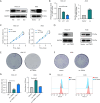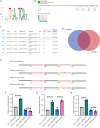TRIP6/c-Fos regulating GPX4 modulates gastric cancer growth by inhibiting ferroptosis
- PMID: 40672107
- PMCID: PMC12261028
- DOI: 10.21037/jgo-22-1178
TRIP6/c-Fos regulating GPX4 modulates gastric cancer growth by inhibiting ferroptosis
Abstract
Background: Gastric cancer (GC) is a digestive system tumor with the highest incidence in China. In recent years, the role of ferroptosis in tumor occurrence and development has received more and more attention. In this study, we sought to identify the genes related to ferroptosis in GC and explain the mechanism of these related genes.
Methods: The Cancer Genome Atlas (TCGA) database was analyzed using bioinformatics technology to identify the gene closely related to ferroptosis [i.e., thyroid hormone receptor interacting protein 6 (TRIP6)]. We then constructed the knockdown and overexpression of TRIP6 cell lines to verify the effects of TRIP6 on cell proliferation and ferroptosis using quantitative polymerase chain reaction (qPCR), western blot, co-immunoprecipitation (CO-IP), flow analysis, dual-luciferase report, and other technologies. We also validated the results by ferroptosis inducers and inhibitors.
Results: The bioinformatics analysis showed that ferroptosis is closely related to TRIP6. TRIP6 is highly expressed in GC cells and tissues and is associated with a poor prognosis. The knockdown or overexpression of TRIP6 affects cell proliferation and ferroptosis, which we verified via recovery experiments with ferroptosis activators and inhibitors. TRIP6 also affected the expression of glutathione (GSH) peroxidase 4 (GPX4). The CO-IP and silver staining experiments verified that TRIP6 can bind to the transcription factor c-Fos and stabilize its expression. The dual-luciferase experiment confirmed that the transcription factor c-Fos regulated the expression of GPX4.
Conclusions: TRIP6, which is highly expressed in GC, binds to and stabilizes the expression of c-Fos, which acts as a transcription factor to regulate the expression of GPX4 and thereby inhibit cell ferroptosis.
Keywords: Ferroptosis; c-Fos; gastric cancer (GC); thyroid hormone receptor interacting protein 6 (TRIP6).
Copyright © 2025 AME Publishing Company. All rights reserved.
Conflict of interest statement
Conflicts of Interest: All authors have completed the ICMJE uniform disclosure form (available at https://jgo.amegroups.com/article/view/10.21037/jgo-22-1178/coif). The authors have no conflicts of interest to declare.
Figures






Similar articles
-
Aldo-keto Reductase 1B10 (AKR1B10) Suppresses Sensitivity of Ferroptosis in TNBC by Activating the AKT/GSK3β/Nrf2/GPX4 Axis.Front Biosci (Landmark Ed). 2025 Jun 27;30(6):36615. doi: 10.31083/FBL36615. Front Biosci (Landmark Ed). 2025. PMID: 40613296
-
Perillaldehyde synergizes with ferroptosis inducers to promote ferroptotic cell death in gastric cancer.Front Cell Dev Biol. 2025 Jun 3;13:1598520. doi: 10.3389/fcell.2025.1598520. eCollection 2025. Front Cell Dev Biol. 2025. PMID: 40530331 Free PMC article.
-
GEN1 regulates cell proliferation, migration, apoptosis and ferroptosis in gastric cancer.World J Gastrointest Oncol. 2025 Aug 15;17(8):106781. doi: 10.4251/wjgo.v17.i8.106781. World J Gastrointest Oncol. 2025. PMID: 40837761 Free PMC article.
-
Signs and symptoms to determine if a patient presenting in primary care or hospital outpatient settings has COVID-19.Cochrane Database Syst Rev. 2022 May 20;5(5):CD013665. doi: 10.1002/14651858.CD013665.pub3. Cochrane Database Syst Rev. 2022. PMID: 35593186 Free PMC article.
-
Targeting ferroptosis using Chinese herbal compounds to treat respiratory diseases.Phytomedicine. 2024 Jul 25;130:155738. doi: 10.1016/j.phymed.2024.155738. Epub 2024 Jun 1. Phytomedicine. 2024. PMID: 38824825
References
LinkOut - more resources
Full Text Sources
Miscellaneous
